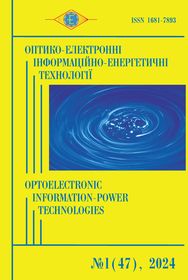Оцінка можливостей бібліотеки ARCORE для визначення дистанції до об’єктів у кадрі
DOI:
https://doi.org/10.31649/1681-7893-2024-47-1-58-65Ключові слова:
доповнена реальність, здоров’я людини, мапа глибини, просторова орієнтація незрячих, фреймворк ARCore.Анотація
Це дослідження вивчає потенціал ARCore для розробки систем навігації, призначених для мобільних додатків, які будуть працювати на швидкості пішохода, таких як допомога в навігації для людей з порушеннями зору. Оцінюючи продуктивність програми, ми виявили, що поточна точність вимірювань і похибка до 7,5% є прийнятними для цих умов. Навігаційна система на основі ARCore може значно покращити просторову орієнтацію, надаючи інформацію про відстань до об'єктів та перешкод у реальному часі. Інтеграція з аудіопідказками та тактильним зворотним зв'язком обіцяє інтуїтивну навігацію, дозволяючи людям з порушеннями зору самостійно та безпечно пересуватися як у приміщенні, так і на вулиці. Ці висновки підкреслюють потенціал ARCore для покращення якості життя за рахунок доступних та ефективних навігаційних рішень.
Посилання
Sokolov A., Avrunin O. and Sokolov A., "Theoretical Foundations for Designing Portable Systems for Oriented Blind People," 2022 IEEE 9th International Conference on Problems of Infocommunications, Science and Technology (PIC S&T), Kharkiv, Ukraine, 2022, pp. 379-382, doi: 10.1109/PICST57299.2022.10238588.
Maksym Tymkovych, etc. (2021). Conception of a Mixed Reality Eyesight Training System Based on the Parallel Robot. https://doi.org/10.1109/picst54195.2021.9772244.
World Health Organization: WHO, “Blindness and vision impairment,” Who.int, Oct. 11, 2018. https://www.who.int/en/news-room/fact-sheets/detail/blindness-and-visual-impairment.
Lupton T. and Sukkarieh S., "Visual-Inertial-Aided Navigation for High-Dynamic Motion in Built Environments Without Initial Conditions," IEEE Transactions on Robotics, vol. 28, no. 1, pp. 61-76, Feb. 2012, doi: 10.1109/TRO.2011.2163433.
Sokolov A, Shushliapina Nataliia, A. Sokolov, and K. Selivanova, “Overview Of Modern Augmented Reality Capabilities For Creating A Navigation Aid For The Blind,” Oct. 2023, doi: https://doi.org/10.1109/khpiweek61412.2023.10311579.
“Geospatial quickstart for Android | ARCore,” Google for Developers. https://developers.google.com/ar/develop/java/geospatial/quickstart (accessed Jul. 05, 2024).
Semerenko Yu., Selivanova K. "Possibilities of using modern graphic libraries in specialized online virtual simulation simulators." Electronic, laser and biotechnical engineering, Kharkiv, April 7. 2024 - April 9 2020. 2020. P. 179–180.
“How Visual Inertial Odometry (VIO) Works,” Welcome to The Library!, Apr. 03, 2024. https://www.thinkautonomous.ai/blog/visual-inertial-odometry/ (accessed Jun. 22, 2024).
Sokolov A. A. and Avrunin O. H., "Можливості бібліотеки для доповненої реальності Arcore при розробці засобів навігації для незрячих," in Proceedings of the International Scientific and Practical Conference on Modern State and Prospects of Biomedical Engineering, dedicated to the 125th anniversary of the National Technical University of Ukraine "Igor Sikorsky Kyiv Polytechnic Institute", Kyiv, Ukraine, Dec. 13-14, 2023, pp. 202.
Selivanova K. H. and Tymkovych M. Yu., "Проєктування телемедичної системи об’єктивізованої оцінки тремору рук із зовнішнім кінестетичним впливом," in Medico-Psychological and Information Aspects of Human Rehabilitation and Habilitation: Collection of Scientific Papers, edited by O. A. Panchenko, Kyiv, Ukraine: KVITS, 2020, pp. 255-257.
Li M. and Mourikis A. I., “High-precision, consistent EKF-based visual-inertial odometry,” International Journal of Robotics Research, vol. 32, no. 6, pp. 690-711, May 2013. doi: 10.1177/0278364913481251.
Sokolov A. A. Peculiarities of spatial perception in training systems, Aviation, industry, society: materials IV International. science and practice conf. (Kremenchuk, May 18, 2023) / Ministry of Internal Affairs of Ukraine, Kharkiv. national University of Internal Affairs affairs, Kremenchuts. Flight College, Science Park "Science and Safety". - Kharkiv: KhNUVS, 2023. - P. 358-361.
Kolisnyk, K., Deineko, D., Sokol, T., Kutsevlyak, S., & Avrunin, O. (2019, October 1). Application of Modern Internet Technologies in Telemedicine Screening of Patient Conditions. IEEE Xplore. https://doi.org/10.1109/PICST47496.2019.9061252.
Avrunin, O., & Bel'aninova, G. (2023). STRONG HEALTH and WELL-BEING are KHNURE'S PRIORITY. Grail of Science, 28, 83–87. https://doi.org/10.36074/grail-of-science.06.09.2023.11.
Avrunin O., Nosova T., and Semenets V.. "Experience of Developing a Laboratory Base for the Study of Modern Microprocessor Systems." Proceedings of I International Scientific and Practical Conference “Theoretical and Applied Aspects of Device Development on Microcontrollers and FPGAs” MC&FPGA-2019, Kharkiv, Ukraine, 2019. pp. 6–8.
Tymkovych Maksym, Avrunin Oleg, Selivanova K., A. Kolomiiets, etc. “CORRESPONDENCE MATCHING IN 3D MODELS FOR 3D HAND FITTING,” Informatyka, Automatyka, Pomiary w Gospodarce i Ochronie Środowiska, vol. 14, no. 1, pp. 78–82, Mar. 2024, doi: https://doi.org/10.35784/iapgos.5498.
Tymkovych Maksym et al., “3D scanning technologies by optical RealSense cameras for SIREN-based 3D hand representation,” Dec. 2023, doi: https://doi.org/10.1117/12.3022737.
Yusuke S., “Measuring distance with ARCore,” Medium, Feb. 16, 2020. https://shibuiyusuke.medium.com/measuring-distance-with-arcore-6eb15bf38a8f.
“Use the ARCore Depth API for immersive augmented reality experiences,” Google Codelabs. https://codelabs.developers.google.com/codelabs/arcore-depth/#0 (accessed Jun. 22, 2024).
Misochenko S. Yu., Selivanova K. G., and Avrunin O. G., "Research on the use of probabilistic methods in the field of biomedical image processing," in Information technologies: science, technology, technology, education, health: theses of reports XX of the international scientific and practical conference MicroCAD-2022, Kharkiv, Ukraine, October 19-21, 2022, p. 902.
“Improving Monocular Visual Odometry Using Learned Depth,” ar5iv. https://ar5iv.labs.arxiv.org/html/2204.01268 (accessed Jul. 05, 2024).
##submission.downloads##
-
PDF
Завантажень: 57
Опубліковано
Як цитувати
Номер
Розділ
Ліцензія
Автори, які публікуються у цьому журналі, погоджуються з наступними умовами:- Автори залишають за собою право на авторство своєї роботи та передають журналу право першої публікації цієї роботи на умовах ліцензії Creative Commons Attribution License, котра дозволяє іншим особам вільно розповсюджувати опубліковану роботу з обов'язковим посиланням на авторів оригінальної роботи та першу публікацію роботи у цьому журналі.
- Автори мають право укладати самостійні додаткові угоди щодо неексклюзивного розповсюдження роботи у тому вигляді, в якому вона була опублікована цим журналом (наприклад, розміщувати роботу в електронному сховищі установи або публікувати у складі монографії), за умови збереження посилання на першу публікацію роботи у цьому журналі.
- Політика журналу дозволяє і заохочує розміщення авторами в мережі Інтернет (наприклад, у сховищах установ або на особистих веб-сайтах) рукопису роботи, як до подання цього рукопису до редакції, так і під час його редакційного опрацювання, оскільки це сприяє виникненню продуктивної наукової дискусії та позитивно позначається на оперативності та динаміці цитування опублікованої роботи (див. The Effect of Open Access).


